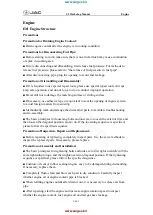
WARNING!
Ignoring the Air Bag Warning Light in your instru-
ment panel could mean you won’t have the air bags
to protect you in a collision. If the light does not come
on as a bulb check when the ignition is first turned
on, stays on after you start the vehicle, or if it comes
on as you drive, have an authorized studio service the
air bag system immediately.
Driver And Passenger Advanced Front Air Bag
Inflator Units
The Driver and Passenger Advanced Front Air Bag
Inflator Units are located in the center of the steering
wheel and on the right side of the instrument panel.
When the ORC detects a collision requiring the Ad-
vanced Front Air Bags, it signals the inflator units. A large
quantity of non-toxic gas is generated to inflate the
Advanced Front Air Bags. Different air bag inflation rates
are possible, based on several factors, including the
collision type and severity. The steering wheel hub trim
cover and the upper right side of the instrument panel
separate and fold out of the way as the air bags inflate to
their full size. The air bags fully inflate in about 50 to
70 milliseconds. This is about half of the time it takes to
blink your eyes. The air bags then quickly deflate while
helping to restrain the driver and front passenger.
The Advanced Front Air Bag gas is vented through the
vent holes in the sides of the air bag. In this way, the air
bags do not interfere with your control of the vehicle.
Supplemental Driver Side Knee Air Bag Inflator
Unit
The Supplemental Driver Side Knee Air Bag unit is
located in the instrument panel trim beneath the steering
column. When the ORC detects a collision requiring the
Advanced Front Air Bags, it signals the inflator units. A
large quantity of non-toxic gas is generated to inflate the
2
THINGS TO KNOW BEFORE STARTING YOUR VEHICLE
45
Supplemental Driver Side Knee Air Bag. The trim cover
separates and folds out of the way allowing the air bag to
inflate to the full size. The air bag fully inflates in about
15 to 20 milliseconds. The Supplemental Driver Side
Knee Air Bag gas is vented through small vent holes in
the side of the air bag.
Supplemental Seat-Mounted Side Air Bag (SAB)
Inflator Units
The Supplemental Seat-Mounted Side Air Bags (SAB) are
designed to activate only in certain side collisions.
The ORC determines if a side collision requires the side
air bags to inflate, based on the severity and type of
collision.
Based on the severity and type of collision, the side air bag
inflator on the crash side of the vehicle may be triggered,
releasing a quantity of non-toxic gas. The inflating SAB
exits through the seat seam into the space between the
occupant and the door. The SAB fully inflate in about
10 milliseconds. The side air bag moves at a very high
speed and with such a high force that it could injure you if
you are not seated properly, or if items are positioned in the
area where the side air bag inflates. This especially applies
to children.
Supplemental Side Air Bag Inflatable Curtain
(SABIC) Inflator Units
During collisions where the impact is confined to a
particular area of the side of the vehicle, the ORC may
deploy the Supplemental Side Air Bag Inflatable Curtain
(SABIC), depending on several factors, including the
severity and type of collision. In these events, the ORC
will deploy the SABIC only on the impact side of the
vehicle.
46
THINGS TO KNOW BEFORE STARTING YOUR VEHICLE
Summary of Contents for 1996 Windstar
Page 1: ...1996 Ford Windstar...
Page 6: ...Safety Restraints Inflated driver side air bag 6 1996 Ford Windstar...
Page 12: ......
Page 13: ......
Page 14: ...0 1 2 3 4 5 6 1 7 7 5 8 9 9 A B C D E E C...
Page 15: ...F G G H I J K L M N O P J K K Q R M S S Q...
Page 16: ......
Page 17: ......
Page 18: ......


































